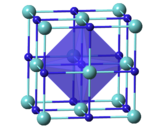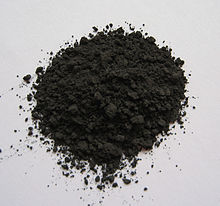
Back كربيد الزركونيوم الرباعي Arabic زیرکونیوم کاربید AZB Zirconiumcarbid German Carburo de circonio Spanish زیرکونیوم کاربید Persian Zirkoniumkarbidi Finnish Carbure de zirconium French जिरकोनियम कार्बाइड Hindi Ցիրկոնիումի կարբիդ Armenian Carburo di zirconio Italian

| |

| |
| Names | |
|---|---|
| Other names
Zirconium(IV) carbide
| |
| Identifiers | |
3D model (JSmol)
|
|
| ECHA InfoCard | 100.031.920 |
| EC Number |
|
PubChem CID
|
|
| RTECS number |
|
| UN number | 3178 |
CompTox Dashboard (EPA)
|
|
| |
| Properties | |
| ZrC | |
| Molar mass | 103.235 g·mol−1 |
| Appearance | Gray refractory solid |
| Odor | Odorless |
| Density | 6.73 g/cm3 (24 °C)[1] |
| Melting point | 3,532–3,540 °C (6,390–6,404 °F; 3,805–3,813 K)[1][2] |
| Boiling point | 5,100 °C (9,210 °F; 5,370 K)[2] |
| Insoluble | |
| Solubility | Soluble in concentrated H2SO4, HF,[1] HNO3 |
| Structure | |
| Cubic, cF8[3] | |
| Fm3m, No. 225[3] | |
a = 4.6976(4) Å[3] α = 90°, β = 90°, γ = 90°
| |
| Octahedral[3] | |
| Thermochemistry | |
Heat capacity (C)
|
37.442 J/mol·K[4] |
Std molar
entropy (S⦵298) |
33.14 J/mol·K[4] |
Std enthalpy of
formation (ΔfH⦵298) |
−207 kJ/mol (extrapolated to stoichiometric composition)[5] −196.65 kJ/mol[4] |
| Hazards | |
| Occupational safety and health (OHS/OSH): | |
Main hazards
|
Pyrophoric |
| GHS labelling: | |
  [6] [6]
| |
| Danger | |
| H228, H302, H312, H332[6] | |
| P210, P280[6] | |
| NFPA 704 (fire diamond) | |
| Related compounds | |
Other anions
|
Zirconium nitride Zirconium oxide |
Other cations
|
Titanium carbide Hafnium carbide Vanadium carbide Niobium carbide Tantalum carbide Chromium carbide Molybdenum carbide Tungsten carbide |
Except where otherwise noted, data are given for materials in their standard state (at 25 °C [77 °F], 100 kPa).
| |
Zirconium carbide (ZrC) is an extremely hard refractory ceramic material,[7] commercially used in tool bits for cutting tools. It is usually processed by sintering.
- ^ a b c Lide, David R., ed. (2009). CRC Handbook of Chemistry and Physics (90th ed.). Boca Raton, Florida: CRC Press. ISBN 978-1-4200-9084-0.
- ^ a b Perry, Dale L. (2011). Handbook of Inorganic Compounds (2nd ed.). CRC Press. p. 472. ISBN 978-1-4398-1461-1.
- ^ a b c d Kempter, C. P.; Fries, R. J. (1960). "Crystallographic Data. 189. Zirconium Carbide". Analytical Chemistry. 32 (4): 570. doi:10.1021/ac60160a042.
- ^ a b c Zirconium carbide in Linstrom, Peter J.; Mallard, William G. (eds.); NIST Chemistry WebBook, NIST Standard Reference Database Number 69, National Institute of Standards and Technology, Gaithersburg (MD) (retrieved 2014-06-30)
- ^ Baker, F. B.; Storms, E. K.; Holley, C. E. (1969). "Enthalpy of formation of zirconium carbide". Journal of Chemical & Engineering Data. 14 (2): 244. doi:10.1021/je60041a034.
- ^ a b c Sigma-Aldrich Co., Zirconium(IV) carbide. Retrieved on 2014-06-30.
- ^ Measurement and theory of the hardness of transition- metal carbides , especially tantalum carbide. Schwab, G. M.; Krebs, A. Phys.-Chem. Inst., Univ. Muenchen, Munich, Fed. Rep. Ger. Planseeberichte fuer Pulvermetallurgie (1971), 19(2), 91-110
© MMXXIII Rich X Search. We shall prevail. All rights reserved. Rich X Search
